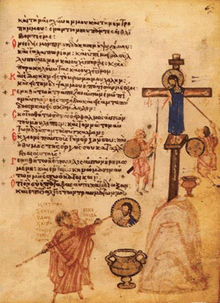John VII Grammatikos

John VII Grammatikos or Grammaticus (* 780 ; † before 867, Greek Ιωάννης Ζ ΄ Γραμματικός, Iōannēs VII Grammatikos) was Patriarch of Constantinople from January 21, 837 to March 4, 843.
John came from an aristocratic family, probably of Armenian origin. His father was Pankaratios Morocharzanios and his brother Arsaber married a sister of the Empress Theodora II. John's sister was the mother of the later Patriarch Photios . In 811, at the beginning of his clerical career, Johannes worked as an icon painter ; he was Ἀναγνώστης ( Anagnōstēs ) in the monastery of the Hodēgoi and a student of Theodor Studites . In 814, Johannes was an iconoclast and Emperor Leo V commissioned him to prepare documents in support of this theological position, which should also serve to reintroduce iconoclasm at the synod of 815 . John was rewarded for his efforts by being appointed abbot of the prestigious Sergios and Bakchos Monastery , where unruly iconic icons were re-educated.
John was known for his eagerness to learn (hence the nickname Grammatikos ), and for his convincing rhetoric in the endless theological debates that accompanied the second phase of the Byzantine Iconoclasm . During the reign of Michael II, John was entrusted with the education of his son, the later emperor Theophilos . In the following years he was responsible for ensuring that his pupil developed a strong sympathy for iconoclasm. After Emperor Theophilos came to power in 829, John became synkellos (Assistant to the Patriarch), a position that made him a candidate for the office of Patriarch. In 830 Johannes was sent with a message to the court of the caliph Al-Ma'mun , but could not prevent the outbreak of violent conflicts between the Byzantine Empire and the Abbasids . However, he brought back a plan of the Abbasid palace in Baghdad from his trip , which impressed his emperor and oversaw the construction of a similar palace in Bithynia .
John VII Grammatikos was appointed patriarch by his pupil Theophilos in 837 and is probably responsible for the further intensification of the persecution of the icon modules. In 843 he was deposed on the advice of the eunuch Theoktistus by Theophilos' widow Theodora (his own relatives). With this she initiated a change of course in church politics, which led to the official restoration of the worship of images at a synod in March 843. At the beginning of the 860s, the deposed patriarch was still alive.
literature
- Martin Tamcke: Johannes VII. Grammatikos. In: Biographisch-Bibliographisches Kirchenlexikon (BBKL). Volume 22, Bautz, Nordhausen 2003, ISBN 3-88309-133-2 , Sp. 629-631.
- Alice-Mary Talbot, Anthony Cutler: Art. John VII Grammatikos . In: Alexander P. Kazdhan (Ed.): The Oxford Dictionary of Byzantium . Vol. 2. Oxford University Press, New York 1991, ISBN 0-19-504652-8 , pp. 1052 .
- John B. Bury : A History of the Eastern Roman Empire from the Fall of Irene to the Accession of Basil I (AD 802-867) . London 1912.
- Paul Lemerle : Byzantine Humanism: The First Phase. Notes and remarks on education and culture in byzantium from its origins to the 10th century (= Byzantina Australiensia; 3 ). Australian Association for Byzantine Studies, Canberra 1986, ISBN 0-9593626-3-0 , pp. 154-168 .
| predecessor | Office | successor |
|---|---|---|
| Antonios I. |
Patriarch of Constantinople 837–843 |
Methodios I. |
| personal data | |
|---|---|
| SURNAME | John VII Grammatikos |
| ALTERNATIVE NAMES | John VII Grammaticus |
| BRIEF DESCRIPTION | Patriarch of Constantinople |
| DATE OF BIRTH | 780 |
| DATE OF DEATH | before 867 |